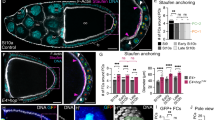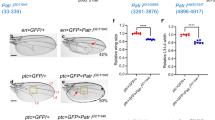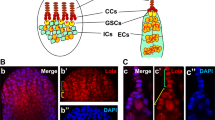Abstract
THE localization of oskar (osk) RNA to the posterior pole of the developing fruit fly (Drosophila) oocyte induces the assembly of pole plasm, causing development of the abdomen and germ line1,2. Failure to localize oskar RNA results in embryos that lack abdomen and germ cells. Conversely, mis-targeting of oskar RNA to the anterior of the oocyte causes formation of ectopic abdomen and germ cells at the anterior pole3. Maternal mutants that have reduced pole plasm activity produce sterile adults with normal abdominal development, suggesting that germ cells are more sensitive than abdomen to defects in pole plasm assembly4. Thus mutations in genes that reduce oskar RNA localization or activity can be recovered as viable sterile adults. In a screen for mutants defective in germ cell formation, we isolated nine alleles of the tropomyosin II gene5. Here we show that mutations in tropomyosin II (TmII) virtually abolish oskar RNA localization to the posterior pole, suggesting an involvement of the actin network in oskar RNA localization.
This is a preview of subscription content, access via your institution
Access options
Subscribe to this journal
Receive 51 print issues and online access
$199.00 per year
only $3.90 per issue
Buy this article
- Purchase on Springer Link
- Instant access to full article PDF
Prices may be subject to local taxes which are calculated during checkout
Similar content being viewed by others
References
Ephrussi, A., Dickinson, L. K. & Lehmann, R. Cell 66, 37–50 (1991).
Kim-Ha, J., Smith, J. L. & Macdonald, P. M. Cell 66, 23–35 (1991).
Ephrussi, A. & Lehmann, R. Nature 358, 387–392 (1992).
Lehmann, R. & Nüsslein-Volhard, C. Cell 47, 141–152 (1986).
Karlik, C. C. & Fyrberg, E. A. Molec. cell. Biol. 6, 1965–1973 (1986).
Hanke, P. D., Lepinske, H. M. & Storti, R. V. J. biol. Chem. 262, 17370–17373 (1987).
St Johnston, D., Beuchle, D. & Nüsslein-Volhard, C. Cell 66, 51–63 (1991).
Pondel, M. D. & King, M. L. Proc. natn. Acad. Sci. U.S.A. 85, 7612–7616 (1988).
Pokrywka, N. J. & Stephenson, E. C. Devl Biol. 166, 210–219 (1994).
Sundell, C. L. & Singer, R. H. Science 253, 1275–1277 (1991).
Yisraeli, J. K., Sokol, S. & Melton, D. A. Development 108, 289–298 (1990).
Theurkauf, W. E., Alberts, B. M., Jan, Y. N. & Jongens, T. A. Development 118, 1169–1180 (1993).
Clark, I., Giniger, E., Ruohola-Baker, H., Jan, L. Y. & Jan, Y. N. Curr. Biol. 4, 289–300 (1994).
Pokrywka, N. J. & Stephenson, E. C. Devl Biol. 167, 363–370 (1995).
Li, M.-G., McGrail, M., Serr, M. & Hays, T. S. J. Cell Biol. 126, 1475–1494 (1994).
Gutzeit, H. Wilhelm Roux Arch. dev. Biol. 195, 173–181 (1986).
Squire, J. M. Trends neurol. Sci. 66, 409–413 (1983).
Pittenger, M. F., Kazzaz, J. A. & Helfman, D. M. Curr. Opin. Cell Biol. 6, 96–104 (1994).
Langford, G. M., Curr. Opin. Cell Biol. 7, 82–88 (1995).
Kuznetsov, S. A., Langford, G. M. & Weiss, D. G. Nature 356, 722–725 (1992).
Cooley, L. & Theurkauf, W. E. Science 266, 590–595 (1994).
Bier, E. et al. Genes Dev. 3, 1273–1287 (1989).
Hanke, P. D. & Storti, R. V. Molec. cell. Biol. 8, 3591–3602 (1988).
Chou, T.-B., Noll, E. & Perrimon, N. Development 119, 1359–1369 (1993).
Wieschaus, E. & Szabad, J. Devl Biol. 68, 29–46 (1979).
Hales, K. H., Meredith, J. E. & Storti, R. V. Devl Biol. 165, 639–653 (1994).
O'Connell, P. O. & Rosbash, M. Nucleic Acids Res. 12, 5495–5511 (1984).
Berleth, T. et al. EMBO J. 7, 1749–1756 (1988).
Neuman-Silberberg, F. S. & Schüpbach, T. Cell 75, 165–174 (1993).
Xue, F. & Cooley, L. Cell 72, 681–693 (1993).
Stelzer, E. H. K., Stricker, R., Pick, R., Storz, C. & Hänninen, P. Scanning imagings (ed. Wilson, T.) 1028, 146–151, (proc. Soc. Photo-opt. Instrum. Engng Bellingham, WA, 1989).
Author information
Authors and Affiliations
Rights and permissions
About this article
Cite this article
Erdélyi, M., Michon, AM., Guichet, A. et al. Requirement for Drosophila cytoplasmic tropomyosin in oskar mRNA localization. Nature 377, 524–527 (1995). https://doi.org/10.1038/377524a0
Received:
Accepted:
Issue Date:
DOI: https://doi.org/10.1038/377524a0
This article is cited by
-
Subcellular spatial transcriptomics identifies three mechanistically different classes of localizing RNAs
Nature Communications (2022)
-
Fine scale analysis of gene expression in Drosophila melanogaster gonads reveals Programmed cell death 4 promotes the differentiation of female germline stem cells
BMC Developmental Biology (2012)
-
Rescue of tropomyosin deficiency inDrosophilaand human cancer cells by synaptopodin reveals a role of tropomyosin α in RhoA stabilization
The EMBO Journal (2012)
-
Autophagy in Drosophila ovaries is induced by starvation and is required for oogenesis
Cell Death & Differentiation (2011)
-
Genome-wide screen reveals APC-associated RNAs enriched in cell protrusions
Nature (2008)
Comments
By submitting a comment you agree to abide by our Terms and Community Guidelines. If you find something abusive or that does not comply with our terms or guidelines please flag it as inappropriate.



